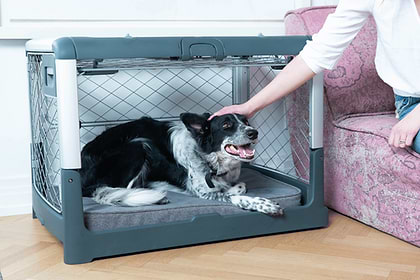So you’ve got a stressed-out dog and you’re not entirely sure why. You provide your pup with shelter, a comfortable place to sleep, a cozy crate, toys, food, and water. What is there to be stressed out about?
While dogs get stressed just like their pet parents do, the determining factors behind our dog’s behavior are not always clear. Either way, we want our furry friend to feel their best, right?
There are various common signs of stress in dogs and a ton of ways to alleviate their symptoms from appetite changes to medical issues like diarrhea, shivering, or constipation. Read on for help to pinpoint your pet’s stress levels and the ways in which you can calm them down.
Signs Your Dog Is Stressed
Pet stress—what does it look like?
Sometimes, it's not too difficult for pet owners to figure out that their pup is stressed. If your little buddy is reacting to common stressors like loud noises, strangers, or separation anxiety, it can be easy to figure out that behaviors like lip-licking, shaking, or restlessness are symptoms of stress. However, less clear triggers like boredom or certain medications can make it difficult to differentiate nervous dogs from a tired dog, aggression, or other common canine emotions.
This is not an exhaustive list of pet stress signals. There are many other indicators. If your dog is exhibiting unusual behavior, consult your vet. It’s always better to get a specialist involved. That being said, here are a variety of stress-related behaviors that you might be noticing in your dog. Being able to detect these behaviors is a good place to start.
Pacing
Just like humans, dogs pace when they are stressed out. Pacing is a sign that your dog can’t settle down because something is bothering them. It could also be a sign of agitation.
Take note of your dog’s surroundings or what kind of task they completed right before they started pacing. Is there a storm in the distance? Is a wild animal close to the house? What are some other factors that might have caused your dog to pace?
Shedding
Anxiety and stress cause dogs to shed more than normal. Nervousness in pups leads to hair loss and excessive shedding. Essentially, whenever your dog is anxious or out of their element, you might notice a nervous shedding response. Dogs can nervously shed while they’re at the vet, when they arrive at a dog park they’ve never been to, or if they’re in another type of unfamiliar setting.
Yawning
Yawning indicates one of three things: your dog is tired, your dog is unphased, or your dog is stressed out. Excessive yawning can be the result of anxiety in pups. You might notice that your dog is yawning on your way to the groomer or to a vet checkup, or when they’ve done something wrong and they know a minor scolding is on the way!
Hiding
Hiding is a sure sign of stress in dogs. Whether it’s behind your legs, under the couch, or in your closet, dogs hide as a way to cope with a stressful situation. Maybe it’s a holiday and there are fireworks being set off, or a bigger dog is close to your home. Whatever the case, your dog is managing their stress by taking cover.
Drooling
Dogs will lick excessively when nervous and might even drool simultaneously. It’s common for stressed-out pups to produce more saliva than normal. Look out for tiny puddles on the floor as this could be the result of a stressed-out dog.
Barking
While barking is very normal, excessive barking can be a sign of stress. Dogs that are afraid or tense may whine or bark to get your attention, or to self-soothe.
Body Posture
Changes in body posture indicate that your pet is experiencing something out of the ordinary. Take a look at their eyes, ears, tail, and spine. Are they crouching? Are their ears pinned back? Can you see the whites of their eyes?
Changes in body posture usually tell us that a dog is stressed out or feeling uncomfortable. Take note and react accordingly.
Destructive Behavior
Anxiety and stress sometimes manifest in the form of destruction in the home. Chewing on furniture, digging holes in the backyard, and scratching doors are all examples of destructive dog behavior due to stress, anxiety, and feelings of unsettlement.
Urinating and Defecating in the House
If your dog is going to the bathroom in all of the wrong places (despite being potty trained), that’s a sign that your dog is anxious or something else is wrong. Consult your vet if this behavior continues.
Why It’s Important To Understand Dog Body Language
Dog body language is the collection of unique methods that a canine uses to communicate their emotions and intentions. It is a compilation of sounds (barks, growls, yawns), physical body adjustments (tail wagging, raised hackles, pinned ears), and even touch (jumping, licking their pet parent). Dogs also communicate through their facial expressions.
There are so many benefits to learning dog body language and your canine’s individual way of communicating with you. Changes in your dog’s body language say a lot about how they’re feeling. If your dog is stressed or anxious, you’ll be able to tell through their body language.
How To Ease Their Stresses
1. Identify the Trigger
Firstly, identify why your dog might be feeling stressed out. Is your pup exhibiting any of the signs above? Why is that? What are your current surroundings and how do they play a role in the anxiety of your animal?
Learning how to identify dog triggers will not only help with the situation at play but will also prevent future moments of stress. Triggers can be environmental, social, or physical.
Examples of dog stress triggers are a chaotic household, moving apartments, fireworks, thunderstorms, nail trimmings, the presence of a cat, physical pain, and more.
2. Remove Them From the Stressor
Once you’ve identified what’s bothering your pup, remove them from the stressor. If your children are running amuck, crate your dog for an hour or two until they calm down. If your pup isn’t enjoying the presence of a cat, take them outside and let them enjoy the sunshine.
Unfortunately, you cannot remove your dog from things like a thunderstorm or a party involving fireworks. In this case, there are ways to ease your pet’s anxiety and give them some peace of mind.
This includes loading them up with treats, toys, their bed and blanket, or sheltering them in an enclosed space (like your bathroom) while drowning out the noise with music or a fan at the same time.
3. Teach Your Children How To Handle a Dog
If your children are the cause of your dog’s stress, there are a multitude of ways to go about this. Teach your kids your dog’s boundaries and limitations, and that they shouldn’t pull their pet’s tail or crowd their space when they’re eating.
Play gentle, don’t shout in their ears or aggressively grab any of their limbs. It is important for your children to know that the dog should be treated with respect.
4. Use the Crate
Crates are proven to ease stress and anxiety in pets. They are a great stress reducer and a powerful tool for dog owners. First and foremost, if you treat your dog’s crate as a safe haven, it will become just that. A crate is a pleasant place for snoozing, soothing, lounging, people watching, and for your pup to enjoy their chews in peace. It’s a stress reliever and a place for your dog to rejuvenate.
Your dog will appreciate their little home within a home. It’s safe and secure, a personal place that has the potential to calm anxiety and get your dog into a happy mindset. A comfy crate is an effective crate, especially if it’s dressed with a crate training tool that’s designed to teach your pet to love their designated space. Cozy it up with an orthopedic crate pad to take it to that next level of snug.
5. Exercise
Exercise and physical activity are effective stress reducers. Going for a long walk, playing fetch, or bringing your dog to a fenced-in park to run and play ball will help release tension. It’s good for their physical health too. Take them to the beach. Throw the ball. Play with a frisbee. Get them moving!
6. Mental Stimulation
Just like physical stimulation, mental exercise is great for stressed-out pets as well. Interactive toys are a great way to get your dog’s brain going and to veer them into a good headspace. Think of it as brain training—fun, cognitive, and a way for your pup to build their skillset. Mental stimulation facilitates in warding off dog stress, sadness, and age-related mental decline.
7. Calming Coats
Stress and anxiety wraps are garments for your dog that are meant to calm them down and decrease their stress. Pet parents sometimes use them when their dog is experiencing storm anxiety or when they are traveling.
The theory is that these vests apply pressure to the torso of the dog which has a calming effect (like swaddling a baby). Gentle pressure like this is supposed to mimic a hug, which releases happy chemicals also known as endorphins.
8. Affection From the Pet Parents
Another way for you to catalyze the release of endorphins in your pet is to give them physical attention like petting, rubbing, and snuggles. Touching and loving on your animal can quickly calm and soothe them.
9. Create a Routine for Your Pet
Supplying your pup with a daily routine is a great way to ease their stresses and give them some peace of mind. Many times, stress and anxiety stem from unpredictability and not knowing what’s coming next. Solidify a schedule that works for you and your pup and stick with it.
With this, consistency is key, although we don’t want your dog to become too dependent on their routine. It is important that despite your dog working off a schedule, they remain flexible and are able to go with the flow.
10. Calming Background Music
Classical music works the same as it does for humans. It has a calming effect. Studies have shown that certain types of music are known to reduce anxiety, lower heart rate, and alleviate certain behaviors in pets. Pop on some pretty notes while your dog is in their crate and see how they react to it.
Summary
In conclusion, there are many ways to lift your dog out of a stress slump. The first step is to acknowledge the signs of your dog’s anxiety and then identify the source of their stress. Pacing, shedding, yawning, hiding, and drooling are all signs of a stressed-out canine, although that is not an exhaustive list. Consult your veterinarian if your dog is exhibiting unusual behavior.
Once you’ve noticed the signs of stress and identified your dog’s triggers, move on to finding a solution that best suits your pet. Remove them from the stressor. Maybe it’s your hyperactive children that are stressing out your pup or the guest that just walked through the door. Move them out of the stressor’s way by putting them in a crate, or leaving them outside for a bit.
Exercise, mental stimulation, calming vests, love from the pet parent, and an established routine are also great stress reducers as well.
At the end of the day, your mental health plays a large role in the mental health of your pup. Make sure you are managing the stressors in your own life so you are able to keep your pup calm, too.
Sources:
How To Tell If Your Dog Is Stressed | American Kennel Club
Signs Your Dog is Stressed and How to Relieve It | VCA Hospitals
Why Do Dogs Yawn? | American Kennel Club
Anxiety in Dogs | Cullen's Archangel Rescue
Teaching Young Children to Respect Dogs | American Kennel Club
Anxiety Vests for Dogs | VCA Animal Hospital
Soothing Sounds: Pet Music Therapy Has Calming Benefits | The Whole Pet Vet
Understanding Dog Body Language: Decipher Dogs' Signs & Signals | American Kennel Club

The Diggs Team
We believe our dogs deserve safer, better designed pet products.
You might also like
Crate training tips, stories and inspiration
View all blogsIn Your Diggs
Share your photos with #DiggsPet and tag us @DiggsPet on IG and TikTok.



